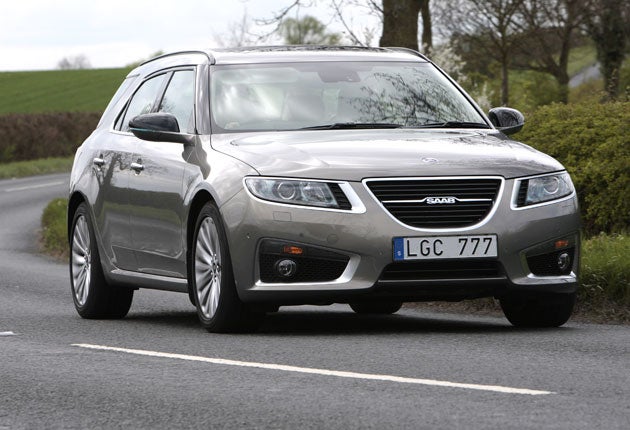Saab 9-5 Sportwagon
New owners have rescued the Swedish carmaker and its engineers have redeemed its rough ride

Your support helps us to tell the story
From reproductive rights to climate change to Big Tech, The Independent is on the ground when the story is developing. Whether it's investigating the financials of Elon Musk's pro-Trump PAC or producing our latest documentary, 'The A Word', which shines a light on the American women fighting for reproductive rights, we know how important it is to parse out the facts from the messaging.
At such a critical moment in US history, we need reporters on the ground. Your donation allows us to keep sending journalists to speak to both sides of the story.
The Independent is trusted by Americans across the entire political spectrum. And unlike many other quality news outlets, we choose not to lock Americans out of our reporting and analysis with paywalls. We believe quality journalism should be available to everyone, paid for by those who can afford it.
Your support makes all the difference.Saab, about a year ago, Phoenix-like from death at the hand of its recent custodian, General Motors, produced the very handsome Saab 9-5.
But it did not get the positive reception from UK pundits that its creators would have liked. Part of the problem lay in the perceived dourness of its dashboard, although, to me, this resolute blackness suggested single-minded, Swedish-tinged functionality rather than darkness of spirit.
More worrying was that the press demonstration cars all had Sport suspension and glamorous, big-diameter wheels shod with racy low-profile tyres. These Saabs looked great – to my eyes the most handsome of today's big saloons – but they dealt miserably with the lumps and bumps that disfigure our roads.
I then drove a 9-5 with Comfort suspension and higher-profile tyres, and it was fine. So good, in fact, that I included it in my European Car of the Year shortlist. Many of the cars sold in the UK have been similarly equipped, and Saab's UK importer says there have been no complaints about them. However, the criticism still hurt pride and, probably, sales.
Then the reborn Saab company ran out of money again and production ground to a halt. Cue another rescue, this time by two hitherto unknown players in the world's largest and fastest-growing car market: China. The companies are Pang Da Automobile Trade and Zhejiang Youngman Lotus Automobile (nothing to do with Lotus sports cars). Between them they now co-own a significant portion of the Dutch company, Spyker, which itself acquired most of Saab from GM.
It's complicated, but it means Saabs are back in production once again. While this has been going on, Saab's engineers have been sorting out the suspension of the 9-5. The changes involve making the ride softer over bumps without spoiling the precision of steering response.
With these revisions comes the Sportwagon, a new estate-car alternative to the existing saloon priced from £29,880. An unusually handsome machine with sleek lines, it has the expected estate-car features, including a large and flat load bay which optionally contains a "U-rail" system in which a pair of posts is joined by telescopic bars. You can move the posts around the U to create a load divider anywhere on the boot floor and at any angle as needed.
To drive, the Sportwagon feels just like the saloon even down to sharing the same degree of road noise insulation at the back, which is not always the case with estate cars. The examples I drove featured the recalibrated suspension systems in various guises, some more successful than others.
The relatively basic 2.0 TiD still felt fidgety despite standard Comfort calibration because it was running on the racy 18in wheels. On smaller wheels it would probably be fine, but buyers demand the big ones and Saab's engineers are determined to give the fashion victims decent comfort. Testing continues before UK sales begin in September. Next, more diesel power and optional adaptive dampers, which felt loose over sharp bumps in Comfort mode, too restless in Sport mode, almost as good as the final car in Intelligent.
That final car had the HiPer strut suspension in Sport specification, a smooth and lusty 220bhp petrol turbo engine, and standard, non-adaptive dampers. This was the one; its steering was crisp, progressive and natural, its ride was supple but controlled. This is how a 9-5 should be, even on 18in wheels, and it shows how good a 9-5 can be. Saab's own engineers like it best, and so do I.
Would it make me buy a 9-5 Sportwagon over an obvious German rival? I do believe it would, not least because it's a refreshing and worthwhile break from the default choices. Own a Saab, and it's clear you've thought about it. And that, in today's brand-obsessed world, has to be a good thing.
The Rivals
Audi A6 Avant 2.0 TFSI: from £29,090, 170bhp, 174g/km
Latest generation A6 has an improved interior, more technology and sharper driving dynamics.
BMW 523i Touring: from £34,990, 204bhp, 185g/km
Cheapest petrol-fuelled 5-series is very expensive, and not quite the driving machine the breed once was.
Mercedes-Benz E200 CGi estate: from £31,310, 184bhp, 184g/km
Lowliest E-class is, perhaps unexpectedly, a more enjoyable drive than the BMW. Latest Mercs ooze old-school quality, too.
Join our commenting forum
Join thought-provoking conversations, follow other Independent readers and see their replies
Comments